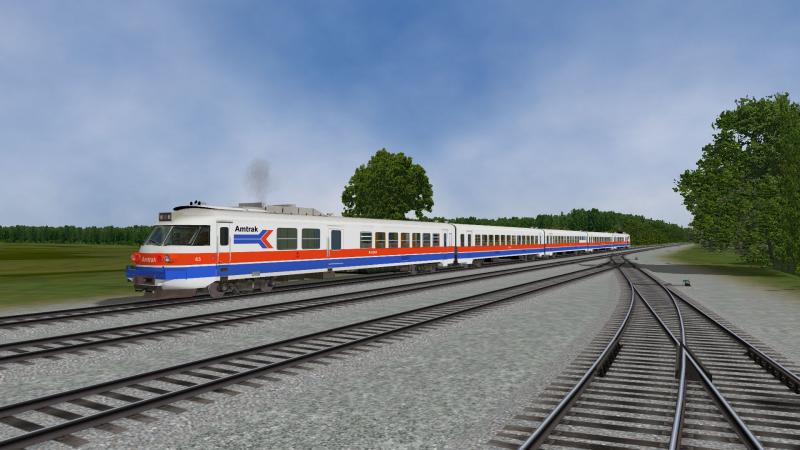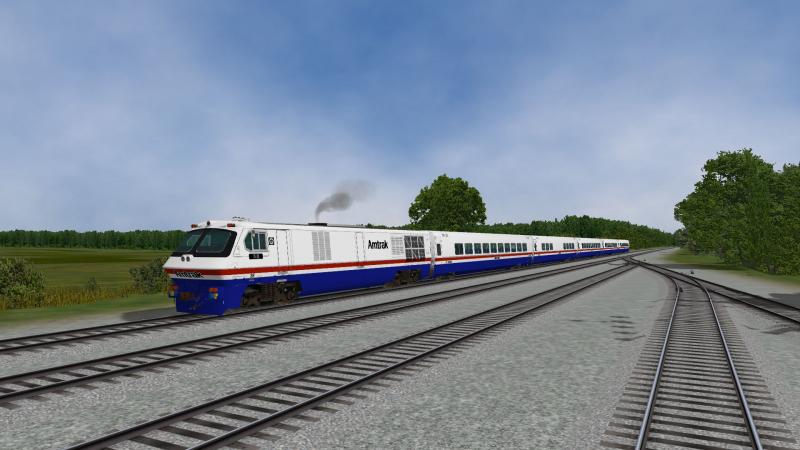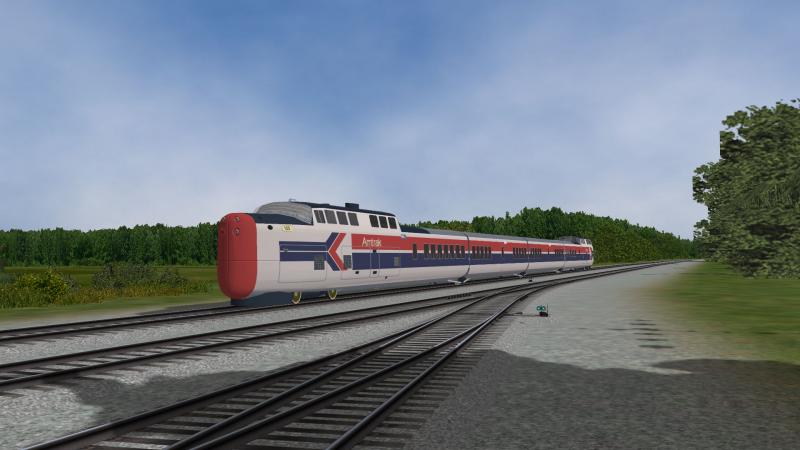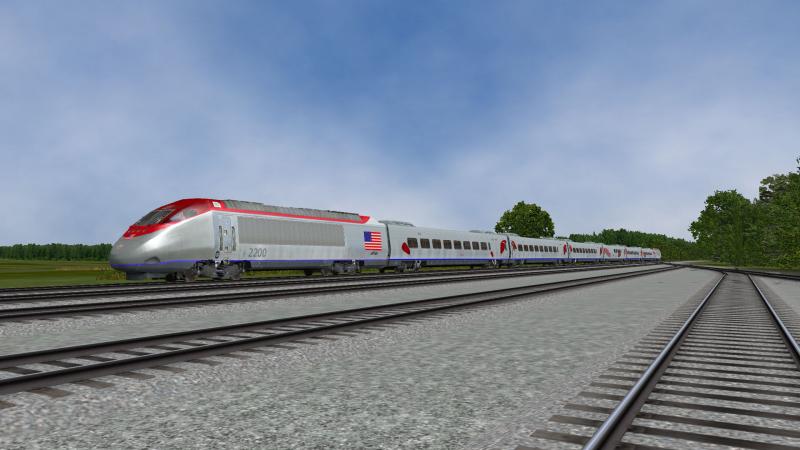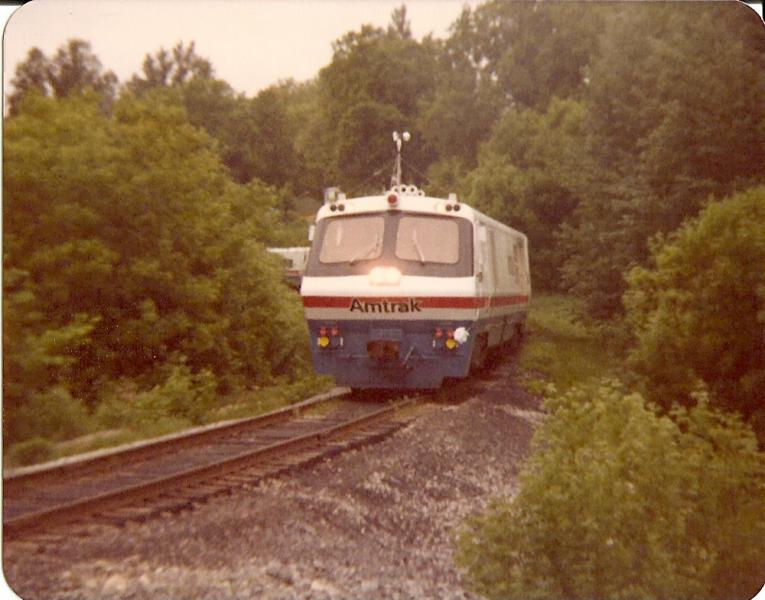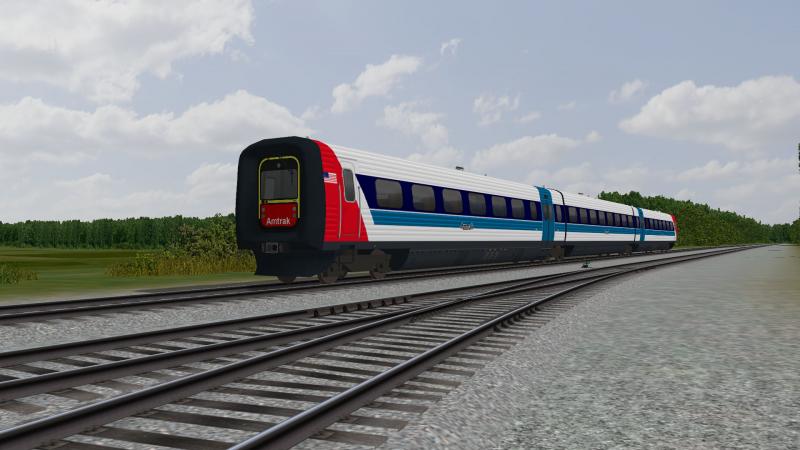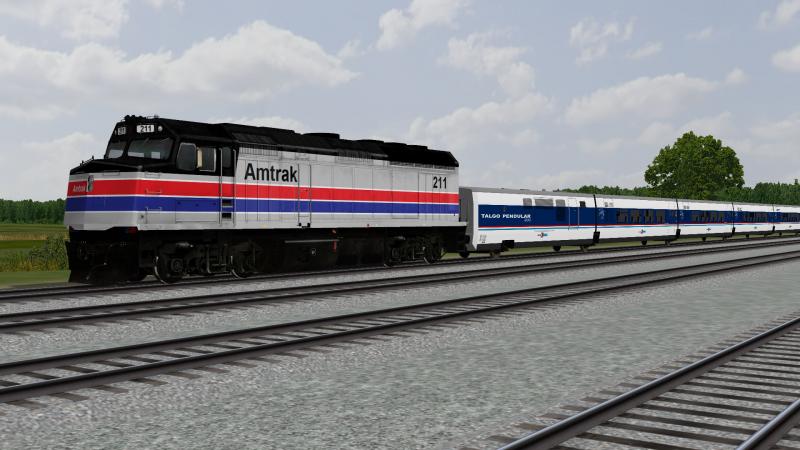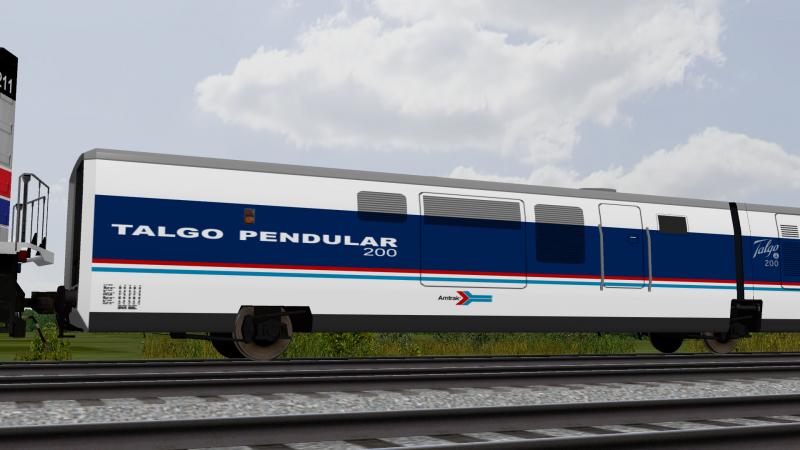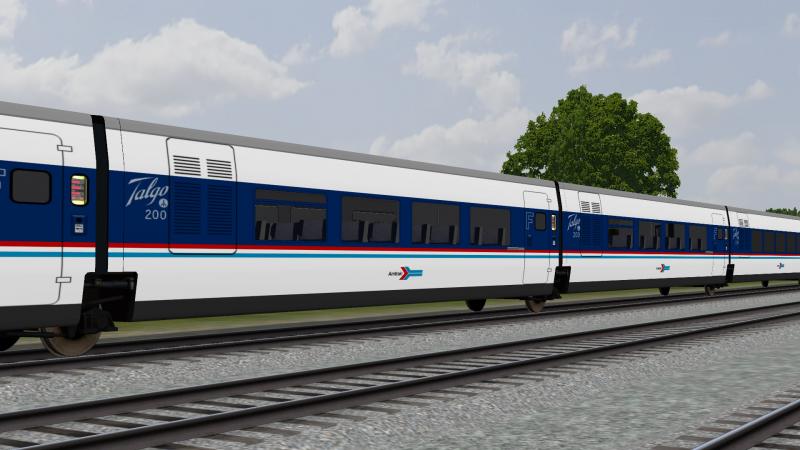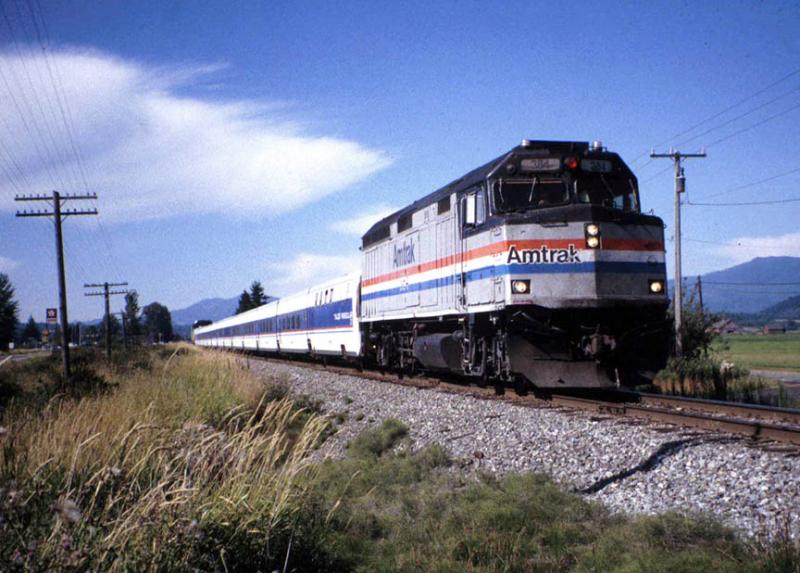AMTK Experiments
#1

Posted 28 October 2017 - 02:39 PM
I've been taking a break from painting for a few days and was instead watching/reading about Amtraks experiments in alternative trains.
This is one of the things about our hobby that is so engaging -- learning about things and then being able to try them out in the game.
Here are a few gems, in order of appearance:
RTG (ANF)
"...The Turboliners were a family of gas turbine trainsets built for Amtrak in the 1970s. They were among the first new equipment purchased by Amtrak to update its fleet with faster, more modern trains. The first batch, known as RTG, were built by the French firm ANF and entered service on multiple routes in the Midwestern United States in 1973. The new trains led to ridership increases wherever used, but the fixed consist proved a detriment as demand outstripped supply. The high cost of operating the trains led to their withdrawal from the Midwest in 1981...." (wikipedia)
LRC (Bombardier)
"...In early 1977, Amtrak agreed to lease two high-speed trainsets designed by the Canadian team of Bombardier, Alcan and Dofasco. Known as "Light, Rapid, Comfortable" - or "LRC" for short - the Amtrak trainsets each included one 16 cylinder, 3725 hp diesel-electric locomotive, four 84-seat coaches and a club car. The lightweight trains were designed to reach speeds up to 125 mph on existing rail infrastructure; tilt technology allowed them to take curves at faster speeds than conventional equipment. During Amtrak testing of a prototype locomotive and car on curved and straight track along the Northeast Corridor, the train achieved top speeds of 89.6 mph and 117 mph, respectively. Amtrak employed the trainsets in revenue service on the Northeast Corridor from 1980-1982. Following expiration of the lease, they were returned to the manufacturer.
..." (https://history.amtrak.com)
TurboTrain (United Aircraft)
"...The UAC TurboTrain was an early high-speed, gas turbine train manufactured by United Aircraft that operated in Canada between 1968 and 1982 and in the United States between 1968 and 1976. (Amtrak disposed of the trains in 1980.) It was one of the first gas turbine powered trains to enter service for passenger traffic, and was also one of the first tilting trains to enter service..." (wikipedia)
JetTrain (Bombardier / USDOT)
"...The JetTrain was an experimental high-speed passenger train created by Bombardier Transportation in an attempt to make European-style high-speed service more financially appealing to passenger railways in North America. It was expected to use the same LRC-derived tilting carriages as the Acela Express trains that Bombardier built for Amtrak in the 1990s and a similar locomotive. Unlike the Acela, powered electrically by overhead lines (as are most other high-speed trains), the JetTrain was designed to use petroleum-based fuel to power a diesel engine and multiple turboshaft engines for higher speeds..." (wikipedia)
This is one of the things about our hobby that is so engaging -- learning about things and then being able to try them out in the game.
Here are a few gems, in order of appearance:
RTG (ANF)
"...The Turboliners were a family of gas turbine trainsets built for Amtrak in the 1970s. They were among the first new equipment purchased by Amtrak to update its fleet with faster, more modern trains. The first batch, known as RTG, were built by the French firm ANF and entered service on multiple routes in the Midwestern United States in 1973. The new trains led to ridership increases wherever used, but the fixed consist proved a detriment as demand outstripped supply. The high cost of operating the trains led to their withdrawal from the Midwest in 1981...." (wikipedia)
LRC (Bombardier)
"...In early 1977, Amtrak agreed to lease two high-speed trainsets designed by the Canadian team of Bombardier, Alcan and Dofasco. Known as "Light, Rapid, Comfortable" - or "LRC" for short - the Amtrak trainsets each included one 16 cylinder, 3725 hp diesel-electric locomotive, four 84-seat coaches and a club car. The lightweight trains were designed to reach speeds up to 125 mph on existing rail infrastructure; tilt technology allowed them to take curves at faster speeds than conventional equipment. During Amtrak testing of a prototype locomotive and car on curved and straight track along the Northeast Corridor, the train achieved top speeds of 89.6 mph and 117 mph, respectively. Amtrak employed the trainsets in revenue service on the Northeast Corridor from 1980-1982. Following expiration of the lease, they were returned to the manufacturer.
..." (https://history.amtrak.com)
TurboTrain (United Aircraft)
"...The UAC TurboTrain was an early high-speed, gas turbine train manufactured by United Aircraft that operated in Canada between 1968 and 1982 and in the United States between 1968 and 1976. (Amtrak disposed of the trains in 1980.) It was one of the first gas turbine powered trains to enter service for passenger traffic, and was also one of the first tilting trains to enter service..." (wikipedia)
JetTrain (Bombardier / USDOT)
"...The JetTrain was an experimental high-speed passenger train created by Bombardier Transportation in an attempt to make European-style high-speed service more financially appealing to passenger railways in North America. It was expected to use the same LRC-derived tilting carriages as the Acela Express trains that Bombardier built for Amtrak in the 1990s and a similar locomotive. Unlike the Acela, powered electrically by overhead lines (as are most other high-speed trains), the JetTrain was designed to use petroleum-based fuel to power a diesel engine and multiple turboshaft engines for higher speeds..." (wikipedia)
#2

Posted 29 October 2017 - 03:48 AM
#4

Posted 29 October 2017 - 09:49 AM
At least as impressive is that he still has his 110 shots! I wish I did.
#5

Posted 17 February 2018 - 07:38 AM
Found another Amtrak experiment!
The IC3 (or class MF) is a Danish-built high-comfort medium/long distance diesel multiple-unit train. The sets were built by ABB Scandia (later purchased by Adtranz, which itself was subsequently acquired by Bombardier Transportation) in Randers.
In 1996, two Adtranz IC3 "Flexliner" trainsets were tested on several Amtrak routes in California, as well as the Metrolink Antelope Valley Line. They retained their Israel Railways livery of white with red, black, and blue sections, with some Amtrak lettering added.
The IC3 (or class MF) is a Danish-built high-comfort medium/long distance diesel multiple-unit train. The sets were built by ABB Scandia (later purchased by Adtranz, which itself was subsequently acquired by Bombardier Transportation) in Randers.
In 1996, two Adtranz IC3 "Flexliner" trainsets were tested on several Amtrak routes in California, as well as the Metrolink Antelope Valley Line. They retained their Israel Railways livery of white with red, black, and blue sections, with some Amtrak lettering added.
#6

Posted 17 February 2018 - 08:57 AM
This too was tested between Ottawa and Toronto through Brockville. They were liked by the riders.
Paul :-)
Paul :-)
#7

Posted 18 February 2018 - 06:41 AM
And yet another..
This time a TALGO (Tren Articulado Ligero Goicoechea Oriol), a Spanish manufacturered trainset which was tested in 1988 first in Germany and then in the United States along the Northeast corridor.
The Talgo Pendular (Talgo IV and Talgo V, also VI & Talgo 200 or 6th generation), introduced in 1980, created the "natural tilting" train, using a passive system that tilts the carriages with no need for electronic sensors or hydraulic equipment.[3] The wheels are mounted on monoaxles between the carriages, and sitting on top of the monoaxles are suspension columns. The carriages are attached to the top of the suspension columns and swing outwards as the train goes through a curve.
Trial commercial services with Talgo cars in the US commenced in 1994 between Seattle and Portland, and from 1998 different trains have been used on the Amtrak Cascades services from Vancouver, British Columbia south to Seattle, Washington, continuing south via Portland, Oregon to Eugene, Oregon.
This time a TALGO (Tren Articulado Ligero Goicoechea Oriol), a Spanish manufacturered trainset which was tested in 1988 first in Germany and then in the United States along the Northeast corridor.
The Talgo Pendular (Talgo IV and Talgo V, also VI & Talgo 200 or 6th generation), introduced in 1980, created the "natural tilting" train, using a passive system that tilts the carriages with no need for electronic sensors or hydraulic equipment.[3] The wheels are mounted on monoaxles between the carriages, and sitting on top of the monoaxles are suspension columns. The carriages are attached to the top of the suspension columns and swing outwards as the train goes through a curve.
Trial commercial services with Talgo cars in the US commenced in 1994 between Seattle and Portland, and from 1998 different trains have been used on the Amtrak Cascades services from Vancouver, British Columbia south to Seattle, Washington, continuing south via Portland, Oregon to Eugene, Oregon.
#8

Posted 18 February 2018 - 06:44 AM
#9

Posted 19 February 2018 - 12:53 PM
 Railroad Librarian, on 18 February 2018 - 06:41 AM, said:
Railroad Librarian, on 18 February 2018 - 06:41 AM, said:
And yet another..
This time a TALGO (Tren Articulado Ligero Goicoechea Oriol), a Spanish manufacturered trainset which was tested in 1988 first in Germany and then in the United States along the Northeast corridor.
The Talgo Pendular (Talgo IV and Talgo V, also VI & Talgo 200 or 6th generation), introduced in 1980, created the "natural tilting" train, using a passive system that tilts the carriages with no need for electronic sensors or hydraulic equipment.[3] The wheels are mounted on monoaxles between the carriages, and sitting on top of the monoaxles are suspension columns. The carriages are attached to the top of the suspension columns and swing outwards as the train goes through a curve.
Trial commercial services with Talgo cars in the US commenced in 1994 between Seattle and Portland, and from 1998 different trains have been used on the Amtrak Cascades services from Vancouver, British Columbia south to Seattle, Washington, continuing south via Portland, Oregon to Eugene, Oregon.
This time a TALGO (Tren Articulado Ligero Goicoechea Oriol), a Spanish manufacturered trainset which was tested in 1988 first in Germany and then in the United States along the Northeast corridor.
The Talgo Pendular (Talgo IV and Talgo V, also VI & Talgo 200 or 6th generation), introduced in 1980, created the "natural tilting" train, using a passive system that tilts the carriages with no need for electronic sensors or hydraulic equipment.[3] The wheels are mounted on monoaxles between the carriages, and sitting on top of the monoaxles are suspension columns. The carriages are attached to the top of the suspension columns and swing outwards as the train goes through a curve.
Trial commercial services with Talgo cars in the US commenced in 1994 between Seattle and Portland, and from 1998 different trains have been used on the Amtrak Cascades services from Vancouver, British Columbia south to Seattle, Washington, continuing south via Portland, Oregon to Eugene, Oregon.
The Talgo trains were also tried in the 1950s-60s.
Quote
Talgo II coaches and locomotives were first built in 1950 at the American Car and Foundry Company (ACF) (the diesel-electric locomotives were assembled by ACF with electrical components made by General Electric) works in the United States under the direction of Spanish engineers, and entered service on the Rock Island Line, servicing the Jet Rocket train, between Chicago and Peoria, Illinois. One was also trialed on the New York Central Railroad until 1958 but saw little success. Talgos were also built for the New York, New Haven and Hartford Railroad for its "John Quincy Adams" train from (New York City to Boston, Massachusetts), and the Boston and Maine Railroad for its "Speed Merchant" train, running between (Boston, Massachusetts and Portland, Maine). Soon afterwards, Talgo II trains began running in Spain, and were successfully operated until 1972.
The NH "John Quincy Adams" and the B&M "Speed Merchant" were each purchased by the Patrick McGinnis administration, as he took over the B&M after being ousted by the New Haven.
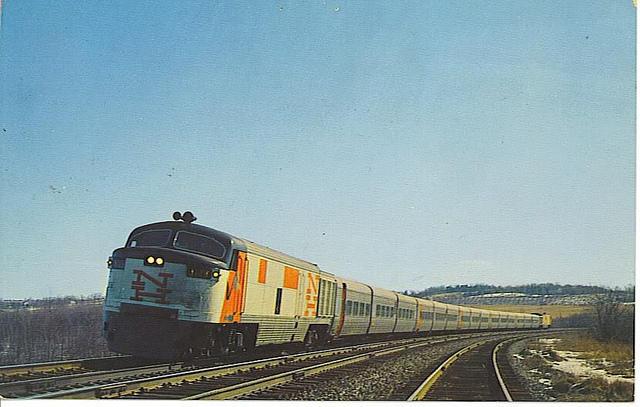
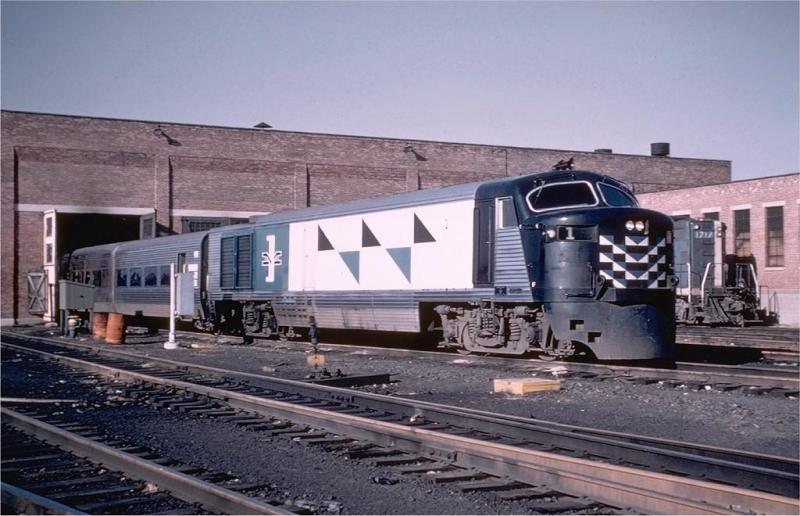
#10

Posted 19 February 2018 - 01:29 PM
The TALGO concept has been tried here in the US many times and has not worked.
Whether it was the F-M Speed Merchant, or the BLH XPlorer, or the EMD Aerotrain, or the UA TurboTrain.
Why not?
1) Light weight + Few Wheels = Rough-Riding on US ROWs?
2) Fixed/Inflexible Consist could not adapt to changing ridership.
3) Failure of one "Power Unit" deadlines the whole train?
4) It jus' duzzent look like a US Train?
When the UA TurboTrain was running on the NH, I drove down to the TurboTrain Service Shop in Providence, RI,
to get a close-up look at them. Got a few good shots in the service bays before being throw-out by an
obnoxious employee. I assume he was unemployed a few years later when the TurboTrains went out-of-service.
Whether it was the F-M Speed Merchant, or the BLH XPlorer, or the EMD Aerotrain, or the UA TurboTrain.
Why not?
1) Light weight + Few Wheels = Rough-Riding on US ROWs?
2) Fixed/Inflexible Consist could not adapt to changing ridership.
3) Failure of one "Power Unit" deadlines the whole train?
4) It jus' duzzent look like a US Train?
When the UA TurboTrain was running on the NH, I drove down to the TurboTrain Service Shop in Providence, RI,
to get a close-up look at them. Got a few good shots in the service bays before being throw-out by an
obnoxious employee. I assume he was unemployed a few years later when the TurboTrains went out-of-service.

 Log In
Log In Register Now!
Register Now! Help
Help



